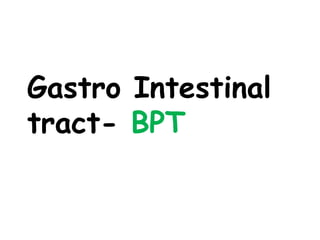Gastro Intestinal tract- BPT.pptx physiotherapy
The gastrointestinal (GI) tract, also known as the digestive tract or alimentary canal, is a complex system responsible for the digestion and absorption of nutrients, as well as the elimination of waste from the body. It is a continuous tube that begins at the mouth and ends at the anus, comprising several organs, each with unique functions. 1. **Mouth**: The process of digestion begins in the mouth with mechanical breakdown (chewing) and chemical breakdown (enzymatic action of saliva, which contains amylase to break down carbohydrates). The tongue helps in the manipulation of food for chewing and swallowing. 2. **Pharynx and Esophagus**: After swallowing, food passes through the pharynx, a common pathway for both food and air. From there, it moves into the esophagus, a muscular tube that propels food downward through rhythmic contractions known as peristalsis, towards the stomach. 3. **Stomach**: The stomach serves as a temporary storage site for food and continues the mechanical breakdown initiated in the mouth. Gastric juices, primarily hydrochloric acid and pepsin, help to further break down food into a semi-liquid substance called chyme. The stomach also secretes intrinsic factor, necessary for the absorption of vitamin B12 in the small intestine. 4. **Small Intestine**: The small intestine is the longest part of the GI tract and the primary site for nutrient absorption. It consists of three segments: the duodenum, jejunum, and ileum. Enzymes from the pancreas and bile from the liver aid in the breakdown of carbohydrates, proteins, and fats. Villi and microvilli in the small intestine increase its surface area, facilitating nutrient absorption into the bloodstream. 5. **Large Intestine (Colon)**: The colon absorbs water and electrolytes from the remaining indigestible food matter, forming solid waste (feces). Beneficial bacteria in the colon aid in the fermentation of undigested carbohydrates, producing vitamins like vitamin K and some B vitamins. The colon consists of several segments: the cecum, ascending colon, transverse colon, descending colon, sigmoid colon, and rectum. 6. **Rectum and Anus**: Fecal matter is stored in the rectum until it is expelled through the anus during defecation. The GI tract is regulated by a complex interplay of hormonal, neural, and local factors to ensure the efficient digestion and absorption of nutrients while protecting the body from harmful pathogens and toxins. Disorders of the GI tract, such as gastroesophageal reflux disease (GERD), peptic ulcers, inflammatory bowel disease (IBD), and colorectal cancer, can significantly impact health and quality of life. Therefore, maintaining a balanced diet, staying hydrated, and seeking medical attention for any persistent GI symptoms are essential for overall well-being.The gastrointestinal (GI) tract is a vital system responsible for digestion, absorption of nutrients, and waste elimination.

Recommended
Recommended
More Related Content
Similar to Gastro Intestinal tract- BPT.pptx physiotherapy
Similar to Gastro Intestinal tract- BPT.pptx physiotherapy (20)
Recently uploaded
Recently uploaded (20)
Gastro Intestinal tract- BPT.pptx physiotherapy
- 2. Digestion • Process by which food is broken into simpler chemical substances that can be absorbed and used as nutrients
- 4. Primary digestive organs • Mouth • Pharynx • Esophagus • Stomach • Small intestine • Large intestine
- 5. Accessory digestive organs • Teeth • Tongue • Salivary glands • Liver • Gall bladder • Exocrine part of pancreas
- 6. Functions of digestive system • Ingestion and digestion of food • Nutrient absorption • Secretion of water and enzymes • Excretion of waste products
- 7. Nerve supply of GIT Two types 1. Intrinsic nerve supply [enteric nervous system] 2. Extrinsic nerve supply
- 8. Enteric nervous system • Present within the wall of GIT • From esophagus to anus • Nerve fibers are interconnected and form two 2 major networks 1. Auerbach’s plexus 2. Meissner’s plexus
- 9. Auerbach’s plexus • Also called myenteric plexus • Regulates the movement of GIT • Accelerates the movements by secreting excitatory NTs like Ach, serotonin etc • Inhibits the movements by secreting inhibitory NTs like VIP
- 10. Meissner’s plexus • Submucus nerve plexus • Regulates the secretory functions of GIT • These cause constriction of blood vessels of GIT
- 11. Extrinsic nerve supply • Controls the enteric NS • Nerves are from autonomic nervous system
- 12. Composition of Saliva • 99.5 % water • 0.5 % organic and inorganic salts • Daily output : 1.5 l • Secreted by salivary glands • Enzymes: salivary amylase • pH : 6-7
- 13. Salivary glands 1. Parotid glands 2. Sub maxillary glands 3. Sub lingual glands
- 14. Functions of saliva • Preparation of food for swallowing • Appreciation of taste • Digestive function- salivary amylase • Cleansing and protective functions • Role in speech • Excretory function-nitrogenous waste • Regulation of body temperature • Regulation of water balance
- 15. Regulation of salivary secretion • Regulated by nervous mechanism • ANS is involved • Salivary glands are supplied by sympathetic and parasympathetic nerve fibers
- 16. Mastication • Chewing • First mechanical process • Food substances are cut into small particles • Reflex process • Center is medulla and cerebral cortex • Supplied by vth cranial nerve
- 17. • DEGLUTITION -swallowing -a complex reflex mechanism-food is pushed- from oral cavity-esophagus- stomach -3 stages : 1) oral 2) pharyngeal 3) esophageal
- 18. Oral stage • Food enters pharynx from the mouth • Voluntary stage Pharyngeal stage • Bolus is pushed from pharynx into esophagus • Involuntary stage
- 19. Esophageal stage • Involuntary; food enters the stomach from esophagus • When bolus enters the esophagus, peristaltic occurs [contraction and relaxation of muscles in wave pattern] 1. Primary 2. Secondary
- 20. • Primary peristaltic contraction -when bolus reaches the upper part of esophagus, pesristalsis starts • Secondary peristaltic contraction -when the primary contractions are unable, this appear and push the bolus
- 21. Deglutition reflex • Stimulus: food enters the oropharynx • Afferent fibers: oropharyngeal receptors- glossopharyngeal nerve fibers- center • Center: medulla oblongata • Efferent fibers: glossopharyngeal and vagus nerves • Response: peristalsis in esophagus